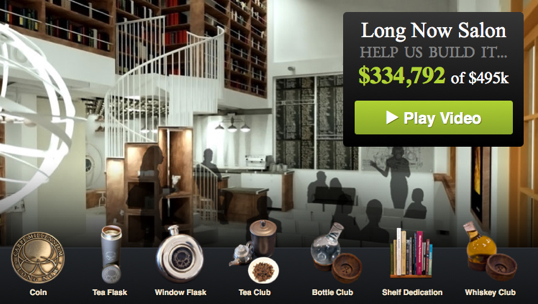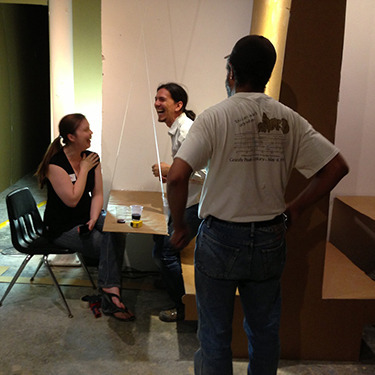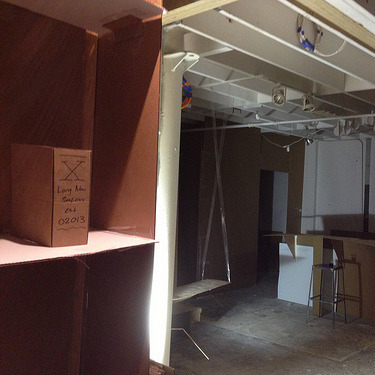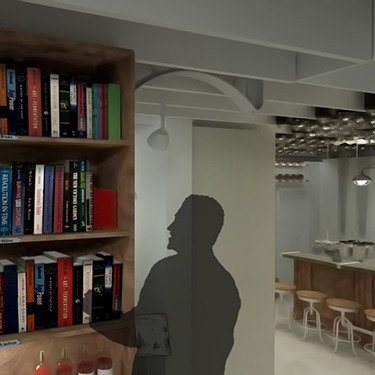Stewart Brand's Blog, page 60
January 20, 2014
Long Now Salon Construction & Fundraising Update – January 02014
Fourteen months ago we announced:
We have begun a campaign to transform our space in Fort Mason into a salon, museum, cafe and bar. We invite you to check out the video and if you can, please support…
As we begin 02014, construction of the Long Now Salon project continues. We’ve also surpassed 2/3 of the needed funding thanks to the generosity of our amazing donors.
While we haven’t finalized the opening date, this is the home stretch of a project that’s been years in the making. That’s not long in terms of the Long Now, a fraction of a century, but this project is very close to home.
The Salon location is also Long Now’s headquarters, and the renovation work required us to move to temporary offices within Fort Mason Center. If you’ve ever worked or lived through a time when your belongings were largely packed away in storage, you can imagine what it has been like for our team for the better part of a year.
We don’t talk about it much, but this project also improves our office setup, redesigned to serve a staff that has roughly doubled since we moved in (though our full-time staff is still only in single digits). That spiral staircase leads up to the office, and, yes, there is a secret door in the bookshelf.
From a construction standpoint, all the work in the concrete floor is done, as well as various drains, plumbing and framing. There was an important electrical upgrade which is complete and now lots of wiring (electrical, heating, and audio visual) is going in.
Building a full scale cardboard prototype of the space in one night last year gave us important insights that lead to design adjustments in seating, sight lines, and the bar area flow. That night staff, donors and Long Now members worked together in what was really the inaugural Salon event. It was inspiring for all involved to get the first inkling of the venue moving from design models into reality.
All that is to say that it won’t be long now. In just a few months the construction will be complete. We will have news about the opening date before you know it. So please stay tuned here on the blog, on Twitter and Facebook for all the news on this and other Salon progress.
Meanwhile there’s lots of preparation. We are working on programming events for the Salon, and Jennifer is planning our bar menu and details like tea service and glassware. We’ve also received 1200 submissions from Salon donors and Long Now members of books for the Salon’s 3500-volume library, our Manual for Civilization.
And we’ve had major progress in raising the funds to complete the renovation. A rush of gifts at the end of 02013 took us past $330K, the two-thirds mark of our goal. The list of Salon donors who got us there includes not only many from San Francisco and the greater Bay Area, but people from around the country and more than a dozen countries around the world.
The list includes celebrated authors, eminent scientists, entrepreneurs, technologists, musicians and artists. Our own Long Now Board members have been generous as a group and individually, including our co-founder Brian Eno who has designed light and sound installations for the Salon.
Just supported @LongNow Salon so that I can have conversations in Old Entish when I am visiting SF http://t.co/KH9S3NRc8R ? via @longnow
— Neal Stephenson (@nealstephenson) June 28, 2013
Our donors hail from New Hampshire to Hawaii; from cities in Finland to small towns in Australia, Croatia, and France. From Albuquerque, Atlanta, Chicago, St. Paul, Salt Lake City, and Cape Town, Glastonbury, Hong Kong, Madrid, Rome, Stockholm, and Zurich. We are blown away by the response.
That support has come in gifts ranging from $10 to $25,000, all of which help us reach our goal. Donors at $100 or above receive a Long Now “Carpe Millenium” Challenge Coin, which has been the most popular level for donations. But there are numerous special gifts we have as thanks, which you’ll find on our ‘brickstarter’ page.
Our fundraising continues as we complete the renovation. We appreciate any way you choose to support the effort. Whether with a tax-deductible gift or by spreading the word about us to your friends online or off. It all helps us on the way.
Salon donors will hear first about all the opening festivities we have planned. Including donor-only events, the debut of our cocktail menu, and dates of the first public events in our new venue. Donors also have the chance to suggest as many books as they’d like for our Manual for Civilization library.
Thanks again for getting us this far, and we can’t wait to see you here:

January 16, 2014
Edge Question 02014
With a new year, of course, comes a new Edge question.
Every January since 01998, John Brockman has presented the members of his online salon with a question that elicits some thinking about the biggest social and intellectual issues of our time. Previous iterations have included prompts such as “What will change everything?” and “What is your favorite deep, elegant, or beautiful explanation?” The essay responses – in excess of a hundred each year – offer a wealth of insight into the direction of today’s cultural forces, scientific innovations, and global trends.
This year, Brockman asks:
What scientific idea is ready for retirement?
Science advances by discovering new things and developing new ideas. Few truly new ideas are developed without abandoning old ones first. As theoretical physicist Max Planck (1858-1947) noted, “A new scientific truth does not triumph by convincing its opponents and making them see the light, but rather because its opponents eventually die, and a new generation grows up that is familiar with it.” In other words, science advances by a series of funerals. Why wait that long? … Ideas change, and the times we live in change. Perhaps the biggest change today is the rate of change. What established scientific idea is ready to be moved aside so that science can advance?
The extensive collection of answers is sure to prompt debate – and, as usual, includes contributions by several Long Now Board members and former SALT speakers:
Paul Saffo suggests we let go of the idea that the expansion of human knowledge diminishes our collective ignorance.
Danny Hillis urges us to recognize that the world is far more complicated than simple cause-and-effect relationships would suggest.
Stewart Brand argues that our current guidelines for radiation exposure are based on no knowledge whatsoever.
Kevin Kelly writes that “random mutation” really isn’t random at all.
Martin Rees suggests we give up the optimistic idea that we’ll never hit the limits of our capacity for understanding.
Mary Catherine Bateson, meanwhile, urges us to shed the notion that knowledge must be absolute and irrefutable in order to be authoritative and significant.
Nassim Taleb proposes that we retire the concept of standard deviation and replace it with that of mean deviation.
Matt Ridley takes an optimistic perspective, and asks us to reject the Malthusian idea that population growth will outpace the development of food supply and depletion of global resources.
Sam Harris urges us to expand our definition of “science” to include any intellectual discipline that “attempts to make valid claims about the world on the basis of evidence and logic.”
Freeman Dyson reminds us that the wave function which describes the motion of particles is merely a description of probability.
Jared Diamond argues that the foundation of this year’s Edge question needs to be retired: many scientific theories do not rise to prominence by replacing an old one.
Steven Pinker argues that we should revisit the simplistic theory that behavior is explained by an interaction of genes and environment.
Daniel Everett, meanwhile, suggests that the notions of “innate” and “instinct” are not very useful in explaining human behavior, either.
George Dyson argues that we should stop thinking of science and technology as inseparable.
These are just a few of 176 compelling responses; you can read the full collection here.

January 15, 2014
02013: The Year in Long Now Seminars
Did you hear the news that LongNow.org has video of the twelve most recent Seminars About Long-term Thinking (SALT) free for everyone to view? It’s true. So here’s an overview of SALT’s tenth year, the dozen Seminars of 02013. You can see the full videos of these talks on our site now. Our first Seminar of 02014 is next week, so it’s the perfect time for some short term nostalgia.
A diverse group of speakers helped us complete our first decade of Seminars. Archeologists, an archivist, an astronaut, a historian of technology, two Long Now Board members, the founder of the MIT Media Lab, a rocket engineer, a drone entrepreneur, a Nobel Laureate, the man who oversees more than a dozen US National museums, and an off the grid globetrotter. Between them they have authored over 40 books, and each presented a thought-provoking contemplation of the Long Now.
Subjects ranged from the timely (Chris Anderson on 3D printing) to the timeless (Craig Childs’ guide to the Everending Earth). We had a trio of Space-themed Seminars: two about reaching out (Peter Schwartz’s The Starships ARE Coming and Adam Steltzner’s Beyond Mars, Earth) and one on a threat coming from Space (Ed Lu’s Thwarting Dangerous Asteroids Begins with Finding Them).
Our speakers included the familiar faces of George Dyson (No Time Is There) and Long Now’s president / co-founder Stewart Brand (Reviving Extinct Species) who each took a third turn in our Seminar spotlight. And for the 6th year in a row we completed the calendar with Rick Prelinger’s Lost Landscapes of San Francisco.
The 02013 Seminar season began a year ago with an archeological detective duo cracking a nearly millennium-old case that everyone thought was closed long ago. Stewart Brand’s summary of The Statues Walked — What Really Happened on Easter Island lays out the facts we thought we knew…
Terry Hunt and Carl Lipo began their archeological work on Easter Island in 2001 expecting to do no more than add details to the standard morality tale of the collapse of the island’s ecology and society—Polynesians discovered Rapa Nui around 400-800AD and soon overpopulated the place (30,000 people on an island the size of San Francisco); competing elites cut down the last trees to move hundreds of enormous statues; after excesses of “moai madness” the elites descend into warfare and cannibalism, and the ecology collapses; Europeans show up in 1722.
But Hunt and Lipo quickly noticed flaws in that narrative. The facts on the ground and the statues beside ancient roads led them to very different conclusions. Here’s a short clip from their talk:
You can watch the Seminar on our site to get the complete story of their groundbreaking research. This is the oldest of the 12 free Seminars, so it will stay on the site only until our first 02014 Seminar is up near the end of January. Watch it while you can!
In March George Dyson’s No Time Is There talk was a dense, enthralling tour of computing history tracing a path from 1941 and Julian Bigelow’s anti-aircraft predictive system (“Maxims of Ideal Prognosticators”) to the smartphone in your pocket. But the incredible human stories which intertwine the science are what make his talk and resultant book (“Turing’s Catherdral“) so much more than a timeline of innovations. For example, these insights into the women who worked on the earliest computer projects at Princeton University’s Institute for Advanced Study (IAS):
Military technology and computer science developed symbiotically, and Dyson highlights IAS and the IAS machine, an early electronic computer used at Princeton on the Manhattan Project to help develop the atomic bomb. The cast of real life characters includes Alan Turing, John von Neumann, Kurt Gödel, and Julian Bigelow–some of the greatest scientific minds the world has known. His research included time spent in von Neumann’s personal library and interviews with others who were there.
Dyson also put in historical perspective the massive datasets, commonly termed “Big Data”, which are a common feature of today’s Cloud-y technological landscape: “Big Data is what happened when the cost of storing information became less than the cost of making the decision to throw it away.”
In April Nicholas Negroponte offered perspective on more recent technological progress in his Beyond Digital Seminar. Did you know that in the 1970′s they thought ‘touch was stupid’?
In August we welcomed Daniel Kahneman, winner of the 02002 Nobel Prize in Economics for his groundbreaking work in behavioral economics. Here’s an excerpt from his talk Thinking Fast and Slow:
This Seminar had an abbreviated Q&A due to a fire alarm going off at the venue. After Dr. Kahneman’s talk detailing his psychological research, some in the audience suspected at first that we were subjects in a live experiment on thinking in a crisis. But alas, no. It was a false alarm all around, though it did end the event prematurely. Watch the full video here.
There isn’t room to recap them all in detail, but we are so proud of the high quality and thoughtfulness of all of these Seminars. Many thanks to our speakers, and all of you who attended in person or enjoyed them online afterwards. You’ll find highlights of a few more 02013 Seminars below. What an incredible year.
And how do we follow that? We begin 02014 with two of our founders Danny Hillis and Brian Eno who will consider the past, present and future in The Long Now, now on January 21, 02014. The Seminar is sold out, but Long Now members can listen in live online. And full video will be on our site about a week after the event. Other speakers this year include Zappos founder Tony Hsieh, Long Now board member and Wired founding editor Kevin Kelly, Colonel Matthew Bogdanos on The Unlooting of Civilization’s Treasures in Wartime Iraq, and Mariana Mazzucato The Entrepreneurial State: Debunking Private vs. Public Sector Myths.
There’s more to come. Check our website and look for full video of talks about a week after they happen (in most cases). Join Long Now to get HD Video of current and past talks and lots more.
Ed Lu: Anthropocene Astronomy: Thwarting Dangerous Asteroids Begins with Finding Them
Craig Childs: Apocalyptic Planet: Field Guide to the Everending Earth
Chris Anderson: The Makers Revolution
Adam Steltzner: Beyond Mars, Earth
Richard Kurin of The Smithsonian American History in 101 Objects

January 14, 2014
Brian Eno & Danny Hillis Seminar Primer
Tuesday January 21, 02014 at the Palace of Fine Arts Theater, San Francisco
Brian Eno and Danny Hillis are long time friends and collaborators. Eno is an influential British musician, producer and artist known both for his work with some of the biggest names in rock as well as his identification and popularization of ambient music. Hillis is an American inventor, scientist, author, and engineer known for his work as one of the key inventors of parallel computing.
It was at MIT that Hillis developed The Connection Machine, the first massively parallel computer, with the help of physicist Richard Feynman. It made use of over 60,000 microprocessors and helped lay the foundation for modern supercomputer architecture. He’s since worked as an Imagineer at Disney, co-founded a research and development company called Applied Minds and spoken at multiple TED events on cancer research and the need for a backup internet.
As the creator of some of the world’s fastest computers, Danny Hillis has helped “enforce” Moore’s law but also to question its effects. Faster and faster computers may help us with certain problems, but they can’t tell us which problems to focus on; instantly available information gives us new insight into the present, but can’t necessarily help us see where we’re going. In mulling over these problems, Hillis sought a way to encourage long-term thinking beyond the newest technological developments and earnings reports.
Danny Hillis first publicly proposed his idea for a clock that could last 10,000 years in 01995, in Wired Magazine. Describing some of the conversations he’d already had about the idea, he mentioned what had come from discussing it with Eno:
“Artist Brian Eno felt it should have a name, so he gave it one: The Clock of the Long Now.”
It was only a year later, in 01996, that Danny Hillis and Brian Eno, along with Stewart Brand and others, turned these conversations into action by forming The Long Now Foundation. In a few more years, Stewart Brand’s book The Clock of the Long Now: Time and Responsibility outlined the guiding philosophy that had been developed in those conversations. It includes an anecdote from Eno about how he came to coin the Clock’s (and the Foundation’s) name: Eno was astonished by the contrast between an acquaintance’s opulent loft and run-down neighborhood.
During dinner I asked the hostess, “Do you like living here?” “Oh sure,” she replied, “this is the loveliest place I’ve ever lived.”
I realized that the “here” she lived in stopped at her front door. This was a very strange thought to me. My “here” includes the neighborhood at least. After that, I noticed that young arty New Yorkers were just as local in their sense of “now.” “Now” meant “this week.” Everyone had just got there, and was just going somewhere else. No one had any investment in any kind of future except their own, conceived in the narrowest terms.
I wrote in my notebook that December, “More and more I find I want to be living in a Big Here and a Long Now.”
Eno recounted this story and expanded on his thoughts around “The Long Now” in the first of the monthly Seminars About Long-term Thinking. He later appeared with SIM City creator Will Wright to discuss the fun and aesthetic potential of generative systems.
That love for generative systems influenced Eno’s involvement in the design of the Clock of the Long Now. He has guided the clock’s sonic component – its chimes. Bells and chimes, in fact, were central to an early form of generative music called change ringing. In that spirit, Eno collaborated with Danny Hillis to ensure that visitors to the Clock will have the opportunity to hear it chime 10 bells in a unique sequence each day at noon.
The story of how this came to be is told by Mr. Eno himself in the liner notes of January 07003: Bell Studies for The Clock of the Long Now, a collection of musical experiments he synthesized and recorded in 02003:
I wrote to Danny Hillis asking whether he could come up with an algorithm for the job. Yes, he wrote back, and in fact he could come up with an algorithm for generating all the possible algorithms for that job. Not having the storage space for a lot of extra algorithms in my studio, I decided to settle for just the one.
A physical prototype of this collaboration, The Chime Generator, lived in the now-closed Long Now Museum & Store and will be viewable again once the Museum re-opens as the Long Now Salon:
10,000-Year Clock: Chime Generator Prototype from The Long Now Foundation on Vimeo.
At the Palace of Fine Arts on January 21st, Eno and Hillis collaborate once more to celebrate the first decade of Long Now’s monthly Seminars About Long-term Thinking, and to usher in the second.
Subscribe to the Seminars About Long-term Thinking podcast for more thought-provoking programs.

January 10, 2014
Lost century-old Antarctic images found and conserved
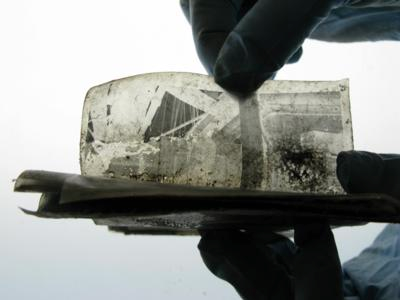
Photo: Antarctic Heritage Trust (NZ)
A small box of 22 exposed but unprocessed photographic negatives left nearly a century ago in an Antarctic exploration hut has been discovered and conserved by New Zealand’s Antarctic Heritage Trust.
“It’s the first example that I’m aware of, of undeveloped negatives from a century ago from the Antarctic heroic era,” Antarctic Heritage Trust Executive Director Nigel Watson said in a press release. “There’s a paucity of images from that expedition.”

Photo: Antarctic Heritage Trust (NZ)
The team of conservationists discovered the clumped together negatives preserved in a solid block of ice in Robert Falcon Scott’s hut at Cape Evans on Ross Island. The hut served as one of the many supply depots of Captain Scott’s doomed Terre Nova Expedition to the South Pole (01910-01913). While the expedition made it to the Pole, they died during the return trip from starvation and extreme conditions. Today, preserved jars of Heinz Tomato Ketchup, John Burgess & Sons French olives and blocks of New Zealand butter can still be found in the hut, as well as a darkroom intact with chemicals and plates.
Two years after Scott’s expedition, the hut was inhabited by the Ross Sea Party of Ernest Shackleton’s Imperial Trans-Antarctic Expedition (01914-01917). Ten marooned men lived there after being stranded on the ice for nearly two years when their ship, the SY Aurora, broke free from her moorings during a blizzard and drifted out to sea. By the time of their rescue, three men had died, including the team’s photographer Arnold Patrick Spencer-Smith. While the photographer of the negatives cannot be proven, someone in the Ross Sea Party did leave behind the undeveloped images.

Chief Scientist Alexander Stevens looking south on the deck of Aurora. Hut Point Peninsula in the background. Photo: Antarctic Heritage Trust (NZ)

Photo: Antarctic Heritage Trust (NZ)
These never-before-seen images give testament to the Heroic Age of Antarctic Exploration. And only in places like Antarctica could such a situation exist. The photographer used cellulose nitrate film, which according to Kodak, is a relatively unstable base. The film breaks down in humidity and higher temperatures, giving off powerful oxidizing agents. However, if the conditions are right, the film may last for decades, or as the Antarctic Heritage Trust discovered, a century.
The photographs found in Captain Scott’s expedition base at Cape Evans, Antarctica required specialist conservation treatment. The Antarctic Heritage Trust (NZ) engaged Photographic Conservator Mark Strange to undertake the painstaking task of separating, cleaning (including removing mould) and consolidating the cellulose nitrate image layers. Twenty-two separate sheets were revealed and sent to New Zealand Micrographic Services for scanning using a Lanovia pre-press scanner. The digital scans were converted to digital positives.

January 9, 2014
Lost Landscapes of San Francisco, 8 Seminar Media
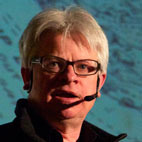 This lecture was presented as part of The Long Now Foundation’s monthly Seminars About Long-term Thinking.
This lecture was presented as part of The Long Now Foundation’s monthly Seminars About Long-term Thinking.
Lost Landscapes of San Francisco, 8
Tuesday December 17, 02013 – San Francisco
Video is up on the Prelinger Seminar page for Members.
*********************
Unlost San Francisco Life – a summary by Stewart Brand
“You are the soundtrack,” Prelinger reminded the 1,400 assembled at the Castro to revel in his eighth mustering of wondrous archival film of San Francisco.
(Long Now people and San Franciscans do love to party, we notice every December at the Castro with Rick. All the more reason to have high expectations for the Long Now Bar (ahem, Salon) under construction at Fort Mason. It will be a non-stop thoughtful party, perhaps lasting centuries, opening in 02014. You can hasten its opening with a contribution.)
Rick’s film this time featured the China Clipper taking off from the water next to the World’s Fair on Treasure Island; another float plane hopping along the water from Oakland to San Francisco as a ferry; the now outlawed traditional downtown blizzard of calendar pages drifting down from highrise offices celebrating the last day of work every December; the dirt roads of Telegraph Hill leading to Julius’ Castle; one of the 80,000 Victory Gardens in the city during World War 2; the bay filled with war ships (no one was supposed to photograph them); a tourist promotion film lauding San Francisco’s “invigorating sea mists”; a drive down historic middle Market Street, with the audience crying out a landmark, “There’s the Twitter Building!”
Subscribe to our Seminar email list for updates and summaries.

January 8, 2014
Brian Eno and Danny Hillis Seminar Tickets
The Long Now Foundation’s monthly
Seminars About Long-term Thinking
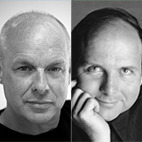
Brian Eno and Danny Hillis present
“The Long Now, now”
TICKETS
Tuesday January 21, 02014 at 7:30pm Palace of Fine Arts
Long Now Members can reserve 1 seat, and a second seat at half-price.
Join today! General Tickets $30
About this Seminar:
Brian Eno delivered the first SALT talk exactly ten years ago. He gave The Long Now Foundation its name, contributed in no end of artistic and financial ways, and designed the chimes for the 10,000-year Clock. Danny Hillis instigated and co-founded Long Now and designed its series of Clocks, culminating currently in the 500-foot one being built inside a west Texas mountain. In the course of their collaboration, Eno and Hillis became fast friends.
Thousands of years pass a decade at a time. The idea and works of Long Now have been active for two decades (1/500th of 10,000 years). Between the conception and initial delivery of a deep idea, much transpires. If the idea resonates with people, it gains a life of its own. Allies assemble, and shape things. Public engagement shapes things. Funding or its absence shapes things. Refinements of the idea emerge, branch off, and thrive or don’t. Initial questions metastasize into potent new questions.
Over time, the promotion of “long-term thinking” begins to acquire a bit of its own long term to conjure with. Eno and Hillis have spent 20 years thinking about long-term thinking and building art for it, with ever increasing fascination. What gets them about it?
Members of Long Now will be able to reserve one complimentary ticket for this special evening, and purchase one additional ticket for a guest.
We anticipate a great deal of interest in this Seminar; please understand that we may not be able to accommodate everyone who would like to attend. There will be audio and video produced of this Seminar; check our blog for media availability.
Members can also tune in to a live audio stream of the Seminar; if you are considering membership, now is a great time to join and support Long Now and our mission to foster long-term thinking.

January 6, 2014
Long Now Seminar Videos for Everyone
We begin 02014 with some big news about online access to our Seminars About Long-term Thinking (SALT). Now for the first time on Longnow.org there is full, free public access to video of the twelve most recent Long Now Seminars. That’s a whole year’s worth, and as new Seminars are added we’ll keep the most recent dozen available. So you may want to watch the oldest ones first.
As we celebrate completing the first decade of our speaking series, we are thrilled to make these talks more available and easier to share. We hope that all of you who listen to Seminar audio podcasts each month will enjoy the ability to watch complete Seminars videos even more.
We’ve launched a redesigned experience for our Seminar pages which includes embeddable/sharable clips of most Seminars, new ways to search our archives or browse by subject, and access to the audio-only version right on the page. This update will help us reach an even wider audience and give everyone interested in Long Now more ways to explore and experience our decade of Seminars.
Long Now members have additional options just for them including HD versions of the videos and download access. Members have access to all Seminars videos, amongst many other benefits.
Our audio podcast remains free as always. Tens of thousands of people around the country and the world listen-in each month. We often hear from listeners who have heard the entire series and cherish the insight and information they’ve gained over the years. We hope the videos will add to everyone’s enjoyment of the series. Seminar recordings are amongst Long Now’s best forms of outreach, so making them more widely available helps us fulfill our mission to promote and encourage long-term thinking.
Long Now members will continue to have access to the complete ten years of Seminar videos, and exclusively have the option to view or download HD video versions of the talks. The support of our membership program, now more than 5,200 strong, enables us to provide this additional general public access to videos. Membership levels start at just $8/month and include many other benefits like tickets to see Seminars in-person and a real time online simulcast of most talks.
SALT speakers address diverse topics spanning the arts, science, policy, history, economics, and more–in all cases bringing a long-term mindset to the areas of their expertise. Seminar speakers have included MacArthur Fellows, Nobel Laureates, Medal of Freedom recipients, and celebrated individuals from academia, business, government, and beyond.
The SALT series began in 02003 and is presented each month live in San Francisco at various venues for in-person audiences of up to 1,200 people. The series is curated and hosted by Long Now’s President Stewart Brand.
We are excited to provide more SALT access to our global online audience. Stay tuned to Long Now’s blog and our Twitter and Facebook page for updates on when new Seminars are available. We hope you will explore and enjoy the Seminars About Long-term Thinking in 02014.

December 31, 2013
Long Now Years: Five-digit Dates and 10K-compliance at Home
Long Now 10-second Intro animation Conceived by Alexander Rose, James Anderson and Chris Baldwin | Sound by Brian Eno
The Long Now Foundation uses five-digit dates to guard against the deca-millennium bug (the “Y10K” problem) which will come into effect in about 8,000 years. As you may have noticed any reference we make to a year begins with a zero: 01977, 03012, 02000, 00521, 01215, etc.
It’s an idiosyncrasy to which we are dedicated. It’s nerdy fun, but it has a serious point, too. As our co-founder Stewart Brand points out: the present moment used to be the unimaginable future.
Long Now is fond of metaphors. Our 10,000 year Clock will begin to keep time at some point in the future, but it functions today as a viral idea carrying a long-term thinking payload. Once you are aware of the effort to build a clock that will last for 10 millennia you can’t unthink the flood of details that come to mind about that endeavor. “Big Time” becomes more tangible and hopefully you gain perspective on the small chronological units we typically give such weight to in our daily lives.
Our zero is for optimism. The notion that the externalized thoughts we write today may survive myriad years to a time when that fifth digit becomes significant. If we hope to grasp anywhere near that ambitious reach, it will require some forethought. Our five-digit dates represent that.
In the 01998 essay Written on the Wind (published in Civilization magazine) Stewart wrote this about the larger problem of digital obsolescence:
How can we invest in a future we know is structurally incapable of keeping faith with its past? The digital industries must shift from being the main source of society’s ever-shortening attention span to becoming a reliable guarantor of long-term perspective. We’ll know that shift has happened when programmers begin to anticipate the Year 10,000 Problem, and assign five digits instead of four to year dates. 01998 they’ll write, at first frivolously, then seriously.
A sense of humor can be a useful sweetener for novel ideas. We hope the five-place-date draws attention to a larger view of time. And if it inspires a grin in the process that’s perhaps even better.
Our technology has come in layers. You are able to read this sentence because generations of programming has built upon binary foundations. Today’s engineers stand on the shoulders of giants and construct protocols, operating systems, programming languages, data formats… so those who follow can continue the process. And that might suggest there’s an inherent awareness of the future. But if the long view and big picture aren’t considered this chain of code can be its own trap.
Technology has blind spots. Hard code can be brittle. The “Y2K bug” demonstrated this. While that experience may seem fresh, there are already people writing code who were too young to take that lesson first hand.
So think of the extra digit as presupposing the future with a view to realizing our best potential. And underlining the need for considered preparation at an appropriate scale: The Big Here and Long Now (Brian Eno).
We invite you to join us in using 5-digit dates, frivolously or not, to inspire yourself and others to keep thinking in the Long Now. And here’s one way you can play along at home…
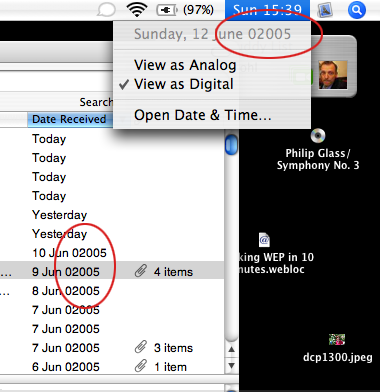
Image courtesy of Michael Hohl
At the cusp of a new year, it’s a great time to tweak your Mac’s clock display for 5-digit dates. In 02007 we first noted this post by a Long Now fan which itself dates to 02005. We haven’t heard about hacks for displaying leading 0′s on other OS’s, but let us know if you’ve got one.
Apple has changed the preference controls with different versions, but here’s the basic gist:
Open “Date & Time” in System Preferences
At the bottom of the window, click “Open Language & Text Preferences”
Click on “Region”
Under “Dates,” click “Customize”
From there you can follow the 02007 instructions
You’ll notice that since we’ve originally posted this we’ve figured out a way to use 5-digit dates on our WordPress blog. Kudos to WordPress for making this easy: just add a zero to the URL pattern in the admin panel. If you’re interested here are more geeky details about how we implemented it. Feel free to fork and improve it!
Happy New Year, and here is to a wonderful 02014!

December 26, 2013
Reviving and Restoring Lost Sounds
In 02008 Kevin Kelly called for movage (as opposed to storage) as the only way to archive digital information:
“Proper movage means transferring the material to current platforms on a regular basis— that is, before the old platform completely dies, and it becomes hard to do. This movic rythym of refreshing content should be as smooth as a respiratory cycle — in, out, in, out. Copy, move, copy, move.”
Five years later, Berkeley physicist Carl Haber received the MacArthur “Genius Grant” for doing just this–moving two- or three-dimensional audio recordings on obsolete platforms and/or decaying storage media and digitally restoring them. These long-lost analog sounds can essentially be played with a virtual needle.
Haber already had the technology in place from his research on imaging radiation. He had cameras precise enough to image and measure the patterns of particles and debris that emerged from subatomic particle collisions. He and his colleagues at the Lawrence Berkeley National Laboratory applied this noninvasive image processing to develop IRENE (Image, Reconstruct, Erase Noise, Etc.). They derived the acronym from the first recording used to demonstrate the concept of IRENE–The Weavers performing “Goodnight Irene.”
Just like the detailed technique required to measure radiation, pictures taken at great magnification are needed to map the surface of an audio recording. One pixel is about one micron on the disc or cylinder surface, meaning in order to acquire a sufficient digital map, the camera scans the object slowly enough to synthesize a gigapixel image:
A disc or cylinder is placed in a precision optical metrology system, where a camera following the path of the grooves on the object takes thousands of images that are then cleaned to compensate for physical damage; the resulting data are mathematically interpolated to determine how a stylus would course through the undulations, and the stylus motion is converted into a standard digital sound file.
So IRENE uses image processing to take a picture and mathematically break down the information in that image to calculate the motion of the groove and determine what sound would actually be played. It’s all done with an algorithm on a computer, never having to touch the recording in the process.
Haber has collaborated with archivists and researchers around the world to test IRENE on a variety of audio recordings. The Smithsonian has about 200 experimental recordings from Volta Laboratory Associates, a collection of some of the earliest audio recordings ever made. It is “a reflection on the intense competition between (Alexander Graham) Bell, Thomas Edison and Emile Berliner for patents following the invention of the phonograph by Edison in 1877.”

A glass disc recording from Bell’s Volta Lab containing the audio of a male voice repeating “Mary had a little lamb.” Photo: The Smithsonian
Now, in collaboration with the Smithsonian and the Library of Congress, IRENE has started to recover these fragile recordings made out of rubber, beeswax, glass, tin foil and brass. The cryptic recordings on such delicate and damaged storage mediums can presently be heard, over a century later:
November 17, 01884: Barometer
April 15, 01885: Alexander Graham Bell’s Voice
Early experimental recordings are not the only recovered lost voices. Anthropologists, linguists and ethnographers were among some of the first to use recording as a research tool and to document cultural heritage. IRENE has restored some of these field recordings, including wax cylinders from the Alfred L. Kroeber collection at the Phoebe A. Hearst Museum of Anthropology in Berkeley. There are over 3,000 cylinder recordings in the collection that document California Native American culture from 01900-01919. Around 300 of these cylinders are 2-3 minute long recordings of Ishi, the only surviving member of the Yahi at the time. 53 of the 300 cylinders are Ishi telling the story of the “Wood Duck” in 01912.
Earlier this month Smithsonian’s National Museum of Natural History received a $1 million grant from the Arcadia Fund to digitize its endangered-language materials, including the estimated 3,000 hours of sound recordings. The recordings will then be electronically available to the public through the Smithsonian’s catalog system:
Digitization of these materials within the NAA (National Anthropological Archives) will give both scholars and local communities new access to documentation of endangered languages and cultural knowledge about threatened environments around the world, ranging from southern California to small Micronesian atolls.
In September 02010, The Library of Congress released the first comprehensive study on a national level examining the preservation of sound recordings in the United States. It found that many historical recordings have already deteriorated or are inaccessible to the public due to their experimental and fragile nature.
“Those audio cassettes are just time bombs,” the study’s co-author Sam Brylawski said. “They’re just not going to be playable.”
But maybe this is not the case after all. Perhaps Haber has taken upon an archaeological endeavor that postpones the detonation of media “time bombs.” It comes back to Kevin Kelly’s idea of movage. Haber has taken big technological steps to digitally play these long-lost analog voices, now the key is to keep on moving.

Stewart Brand's Blog
- Stewart Brand's profile
- 291 followers



